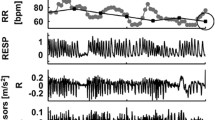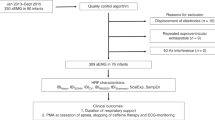Abstract
Long-term recordings of movement in preterm infants might reveal important clinical information. However, measurement of movement is limited because of time-consuming and subjective analysis of video or reluctance to attach additional sensors to the infant. We evaluated whether photoplethysmogram (PPG), routinely used for oximetry in preterm infants in the neonatal intensive care unit (NICU), can provide reliable long-term measurements of movement. In 18 infants [mean post-conceptional age (PCA) 31.10 weeks, range 29–34.29 weeks], we designed and tested a wavelet-based algorithm that detects movement signals from the PPG. The algorithm’s performance was optimized relative to subjective assessments of movement using video and accelerometers attached to two limbs and force sensors embedded within the mattress (five infants, three raters). We then applied the optimized algorithm to infants receiving routine care in the NICU without additional sensors. The algorithm revealed a decline in brief movements (< 5 s) with increasing PCA (13 infants, r = − 0.87, p < 0.001, PCA range 27.3–33.9 weeks). Our findings suggest that quantitative relationships between motor activity and clinical outcomes in preterm infants can be studied using routine photoplethysmography.








Similar content being viewed by others
References
Aarnoudse-Moens, C. S. H., N. Weisglas-Kuperus, J. B. van Goudoever, and J. Oosterlaan. Meta-analysis of neurobehavioral outcomes in very preterm and/or very low birth weight children. Pediatrics 124:717–728, 2009.
Barker, S. J., and N. K. Shah. The effects of motion on the performance of pulse oximeters in volunteers. Anesthesiology 86:101–108, 1997.
Bernhardt, I., M. Marbacher, R. Hilfiker, and L. Radlinger. Inter- and intra-observer agreement of Prechtl’s method on the qualitative assessment of general movements in preterm, term and young infants. Early Hum. Dev. 87:633–639, 2011.
Bickler, P. E., J. R. Feiner, and J. W. Severinghaus. Effects of skin pigmentation on pulse oximeter accuracy at low saturation. Anesthesiology 102:715–719, 2005.
Bruggink, J. L. M., K. N. Van Braeckel, and A. F. Bos. The early motor repertoire of children born preterm is associated with intelligence at school age. Pediatrics 125:e1356–e1363, 2010.
Chan, G. S. H., A. Fazalbhoy, I. Birznieks, V. G. Macefield, P. M. Middleton, and N. H. Lovell. Spontaneous fluctuations in the peripheral photoplethysmographic waveform: roles of arterial pressure and muscle sympathetic nerve activity. Am. J. Physiol. Heart Circ. Physiol. 302:H826–H836, 2012.
Chong, J. W., D. K. Dao, S. M. A. Salehizadeh, D. D. McManus, C. E. Darling, K. H. Chon, Y. Mendelson, and . Photoplethysmograph signal reconstruction based on a novel hybrid motion artifact detection–reduction approach. Part I: motion and noise artifact detection. Ann. Biomed. Eng. 42:2238–2250, 2014.
Couceiro, R., P. Carvalho, R. P. Paiva, J. Henriques, and J. Muehlsteff. Detection of motion artifact patterns in photoplethysmographic signals based on time and period domain analysis. Physiol. Meas. 35:2369–2388, 2014.
Fukumoto, M., N. Mochizuki, M. Takeishi, Y. Nomura, and M. Segawa. Studies of body movements during night sleep in infancy. Brain Dev. 3:37–43, 1981.
Hadders-Algra, M., K. R. Heineman, A. F. Bos, and K. J. Middelburg. The assessment of minor neurological dysfunction in infancy using the Touwen Infant Neurological Examination: strengths and limitations. Dev. Med. Child Neurol. 52:87–92, 2010.
Hayes, M. J., L. S. Plante, B. A. Fielding, S. P. Kumar, and M. Delivoria-Papadopoulos. Functional analysis of spontaneous movements in preterm infants. Dev. Psychobiol. 27:271–287, 1994.
Holditch-Davis, D., D. H. Brandon, and T. Schwartz. Development of behaviors in preterm infants: relation to sleeping and waking. Nurs. Res. 52:307–317, 2003.
Krägeloh-Mann, I., and C. Cans. Cerebral palsy update. Brain Dev. 31:537–544, 2009.
Krishnan, R., B. B. Natarajan, and S. Warren. Two-stage approach for detection and reduction of motion artifacts in photoplethysmographic data. IEEE Trans. Biomed. Eng. 57:1867–1876, 2010.
Kuzniewicz, M. W., S. Wi, Y. Qian, E. M. Walsh, M. A. Armstrong, and L. A. Croen. Prevalence and neonatal factors associated with autism spectrum disorders in preterm infants. J. Pediatr. 164:20–25, 2014.
Mathew, O. P., C. K. Thoppil, and M. Belan. Motor activity and apnea in preterm infants. Is there a causal relationship? Am. Rev. Respir. Dis. 144:842–844, 1991.
McGowan, J. E., F. A. Alderdice, V. A. Holmes, and L. Johnston. Early childhood development of late-preterm infants: a systematic review. Pediatrics 127:1111–1124, 2011.
Moortel, I. D., S. A. Munday, and A. W. Hood. Wavelet Analysis: the effect of varying basic wavelet parameters. Sol. Phys. 222:203–228, 2004.
Munro, B. H. Statistical Methods for Health Care Research. Philadelphia: Lippincott Williams and Wilkins, 2005.
Poets, C. F., and V. A. Stebbens. Detection of movement artifact in recorded pulse oximeter saturation. Eur. J. Pediatr. 156:808–811, 1997.
Selvaraj, N., Y. Mendelson, K. H. Shelley, D. G. Silverman, and K. H. Chon. Statistical approach for the detection of motion/noise artifacts in photoplethysmogram. Conf. Proc. IEEE Eng. Med. Biol. Soc. 2011:4972–4975, 2011.
Shelley, K., and S. Shelley. Pulse oximeter waveform: photoelectric plethysmography. In: Clinical Monitoring, edited by C. Lake, R. Hines, and C. Blitt. Philadelphia: WB Saunders Company, 2001, pp. 420–428.
Shrout, P. E., and J. L. Fleiss. Intraclass correlations: uses in assessing rater reliability. Psychol. Bull. 86:420–428, 1979.
Tobin, R. M., J. A. Pologe, and P. B. Batchelder. A characterization of motion affecting pulse oximetry in 350 patients. Anesth. Analg. 94:S54–S61, 2002.
Torrence, C., and G. P. Compo. A practical guide to wavelet analysis. Bull. Am. Meteorol. Soc. 79:61–78, 1998.
Williamson, J. R., D. W. Bliss, D. W. Browne, P. Indic, E. Bloch-Salisbury, and D. Paydarfar. Individualized apnea prediction in preterm infants using cardio-respiratory and movement signals. 2013. https://doi.org/10.1109/bsn.2013.6575523.
Zuzarte, I., P. Indic, B. Barton, D. Paydarfar, F. Bednarek, and E. Bloch-Salisbury. Vibrotactile stimulation: a non-pharmacological intervention for opioid-exposed newborns. PLoS ONE 2017. https://doi.org/10.1371/journal.pone.0175981.
Zuzarte, I., C. Temple, P. Indic, and D. Paydarfar. Transforming artifact to signal: a wavelet-based algorithm for quantifying neonatal movement. Conf. Proc. IEEE Eng. Med. Biol. Soc. 2014:5466–5469, 2014.
Acknowledgments
The authors thank Courtney Temple and Alan Gee for data collection, Adriell Louis and Hannah Taylor for data annotation; the NICU Staff and Physicians for subject recruitment, and James Niemi and his team at the Wyss Institute for constructing the movement sensor mattress. This work was supported by NSF SCH Grant #1664815, NIH Grants R01-GM104987 and R21-HD089731, and the Wyss Institute at Harvard University.
Author information
Authors and Affiliations
Corresponding author
Additional information
Associate Editor Ka-Wai Kwok oversaw the review of this article.
Rights and permissions
About this article
Cite this article
Zuzarte, I., Indic, P., Sternad, D. et al. Quantifying Movement in Preterm Infants Using Photoplethysmography. Ann Biomed Eng 47, 646–658 (2019). https://doi.org/10.1007/s10439-018-02135-7
Received:
Accepted:
Published:
Issue Date:
DOI: https://doi.org/10.1007/s10439-018-02135-7




